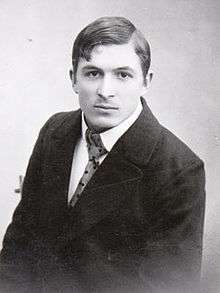Wäinö Aaltonen

Wäinö Valdemar Aaltonen (8 March 1894[1] – 30 May 1966) was a Finnish artist and sculptor. The Chambers Biographical Dictionary describes him as "one of the leading Finnish sculptors".[2]
He was born to a tailor in the village of Karinainen, Finland. He became interested in art after being deaf as a child, and attended the School of Drawing of the Turku Art Association from age 16, or specifically between 1910 and 1915.[3] He had spent many of the early years at this school studying painting, but he was self-taught as a sculptor. A journey he made to Italy in 1923 opened his eyes to cubist and futurist art. These elements can primarily be seen in his paintings.
As the Republic of Finland arose, and the First World War raged, he sculpted War Memorials. He soon became a nationalist icon, the exemplar Finn, establishing an exhibition in Stockholm in 1927. His sculpture is nationalist in nature, and he is noted for monumental figures and busts portraying citizens of Finland. An example is the 1925 sculpture of Paavo Nurmi, a cast of which is exhibited outside the Helsinki stadium. Another notable work is that of Jean Sibelius, a bust of 1928. These two works, like the main body of his work, are bronze casts—though he did work in stone and even glass. Though chiefly naturalistic, the cubist influence is also present here. He was one of the early 20th-century pioneers of direct carving.
He was married four times. A large collection of his works are on permanent exhibition at the Wäinö Aaltonen Museum of Art in Turku.
Works
- Tytön pää, n. 1917
- Graniittipoika, 1917-1920
- Maria Jotuni, 1918-1920
- Opettajani, 1919
- Aaro Hellaakosken pronssipää, 1919
- Savonlinnan sankaripatsas, (The Hero's Grave) 1919-1921
- Punagraniittinen neito, 1923
- Mustagraniittinen neito, 1924
- Paavo Nurmen juoksijapatsas, 1924-1925
- Seisova nainen, 1920-1924
- Istuva nainen, 1920-1925
- Uimaan lähtevä nainen, 1924
- Turun Lilja, n. 1924-1926
- Musica, 1926
- Aleksis Kiven patsas (Tampere), 1926-1927
- Tampereen Hämeensillan patsaat: Eränkävijä, Veronkantaja, Kauppias ja Suomen neito, 1927-1929
- Myrsky (Memorial statue for the 53 victims of the sunken Finnish torpedo boat S2 in Reposaari, Pori), 1930
- Eduskuntatalon täysistuntosalin syvennyksien alastonfiguurit, 1930-1932
- Aleksis Kiven patsas (Helsinki), 1930-1939
- Marjatta, 1934
- Delaware-muistomerkki, 1937-1938
- Vapauden jumalatar seppelöi nuoruuden, 1939-1940
- Tampereen Osuustoimintamuistomerkki, 1949-1950
- Ystävyys solmitaan (Joint monument for the cities of Turku and Gothenburg), n. 1948-1955
- Lahden sankaripatsas, 1952
- Rautatienrakentajien muistomerkki, 1957, Hyvinkää
- Genius ohjaa nuoruutta (in front of the University of Turku main library), 1958-1960
- Presidenttien patsaat eduskuntatalon edessä: K. J. Ståhlberg, 1957-1958 ; P. E. Svinhufvud, 1957-1959
- Genius Montanus (on Aaltonen's grave in Turku), 1960
References
- ↑
- ↑ Chambers Biographical Dictionary, ISBN 0-550-18022-2, page 1
- ↑ Schildt, Göran, Modern Finnish Sculpture. Praeger Publishers, New York, 1970
External links
![]() Media related to Wäinö Aaltonen at Wikimedia Commons
Media related to Wäinö Aaltonen at Wikimedia Commons
- Wäinö Aaltonen Museum of Art in Turku
- Art Signature Dictionary, genuine signature by the artist Wäinö Aaltonen Here are 11 examples of Wäinö Aaltonen's signature and monogram, six dated from 1925 to 1940.